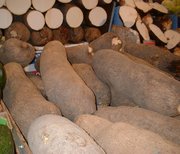| Dioscorea (Yam) | ||||||||||||
|---|---|---|---|---|---|---|---|---|---|---|---|---|
| Scientific classification | ||||||||||||
| ||||||||||||
- Yam is the common name for members of the genus Dioscorea (family Dioscoreaceae). There are more than 150 different varieties of yam. Some species are cultivated for the consumption of their starchy tubers in Africa, Asia and Latin America.
The word yam comes from Portuguese inhame or Spanish ñame, which both ultimately derive from the Wolof word nyami, meaning "to eat". They are used in a similar fashion to potatoes, and are sometimes called a potato substitute, though in areas where yams are grown, potatoes are the newer vegetable.
Yam tubers can grow up to seven feet (approx. two meters) in length and weigh up to 150 pounds (approx. 68 kilograms). The yam has a rough skin which is difficult to peel, but which softens after heating. Yam skins vary in color from dark brown to light pink. The majority of the yam is composed of a much softer substance known as the "meat". This substance ranges in color from white to bright orange in ripe yams.
Yams are a primary agricultural commodity in West Africa and New Guinea. They were first cultivated in Africa and Asia about 8000 B.C., probably because they were able to flourish in environments where growing leafy vegetables and keeping livestock was difficult. To this day, the yam tuber remains crucial to survival in the region; it can be stored for four to six months without refrigeration, which makes it a valuable resource for the yearly period of food scarcity at the beginning of the wet season.
Preparation
Yams must be cooked to be safely eaten because various natural substances in raw yams can cause illness if consumed. Preparing some species of yam is a time-consuming process, involving days of pounding, leaching, and boiling to remove the toxins. Yams may be served boiled or pounded into a paste. In the Philippines, the ube variety of yam is eaten as a sweetened dessert called halaya, and is also an ingredient in the fruity, pudding-like halo-halo, another popular Filipino dessert
Yams and sweet potatoes
In the United States, the sweeter varieties of the sweet potato (Ipomoea batatas) are often mistakenly called "yams". Sweet potato "yams" are widely available in U.S. food stores. True yams are only found in specialty markets such as those that serve Asian or Caribbean communities.
External links and resources
- See also the United States Department of Agriculture's Plant Profile (http://plants.usda.gov/cgi_bin/plant_profile.cgi?symbol=DIOSC) for a complete list of 28 yam species.
- Purdue University's Famine Foods Database (http://www.hort.purdue.edu/newcrop/FamineFoods/ff_home.html) includes a page about how various Dioscoreacea species are used.
- The Consultative Group on International Agricultural Research information page on yams (http://www.cgiar.org/impact/research/yam.html).
- Food Facts & And Trivia: Yams (http://www.foodreference.com/html/fyams.html)
- Vegetable Food Facts, History and Timelines
- African Foods (http://www.historyforkids.org/learn/africa/food/)
- A Taste of Ghana (http://www.ghana.co.uk/food/Glossary/Vegetables.htm)
- The African Table by Jessica Harris. Simon & Schuster: 1996. ISBN 068481837.

